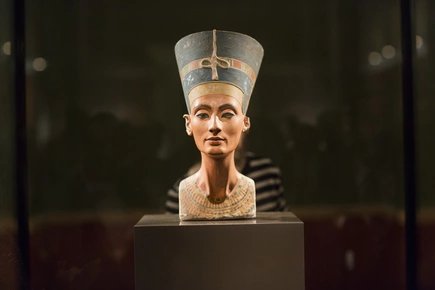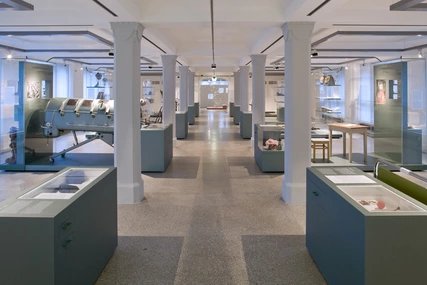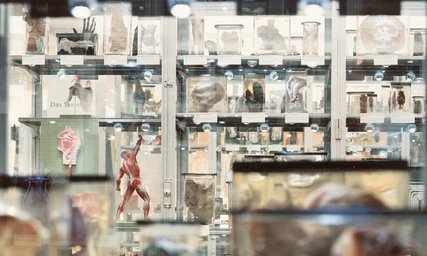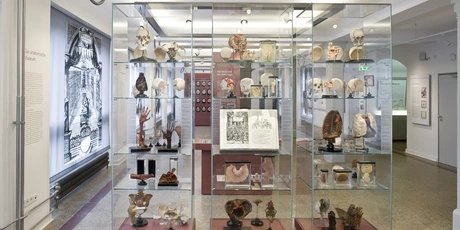
Medizinhistorisches Museum der Charité
300 years of medical history in the heart of Berlin
It has re-opened since June 2023: the Museum of Medical History in the heart of Berlin on the Charité premises. With an extended reception area, a large space for new temporary exhibitions on the first floor and the permanent exhibition on the second floor, it presents itself renovated and with a new concept.
What exactly is happening in our brain? What equipment and special screw racks are required when a patient needs brain surgery and why? And what are the connections between our brain and the nervous system? All questions that are explored in the major new special exhibition The Brain in Science and Art. It will be on display on the first floor until the beginning of 2024; and then it will be replaced by a new temporary exhibition.
In pursuit of life

On the second floor starts the extensive permanent exhibition In pursuit of life.
Historical arm prostheses, preserved organs, moulages and special x-ray images - here you will learn clearly about Details from 300 years of medical history . A tour takes you through historic places such as the Dissecting Room and the Anatomical Theatre. The centrepiece is Rudolf Virchow's specimen collection, details about whose life and achievements are provided by a plaque. Today, the Museum of Medical History shows you around 750 of its preserved and prepared organs - vividly and in all facets between healthy and sick. Pictures and models illustrate the tremendous distance medical research has covered in recent centuries.
In pursuit of Rudolf Virchow
The Museum of Medical History has had many anatomical preparations right from the start. Rudolf Virchow – internationally successful doctor and pathologist - has made many of them himself. He opened the Pathological Museum as part of the Charité in 1899. Today, the permanent exhibition In pursuit of life takes you through Virchow's world and beyond.

The first stop on your tour is the Anatomical Theatre from the early 18th century with its dissecting table and rostrum. After that, you arrive at the pathologists' Dissecting room, where the preparation of the organs begins. Preserved professionally and presented with dignity, you will find them again in the Virchow Collection. Each glass case shows a different part of the body. So, for example, you can clearly see the different stages of a brain tumour or look at what a heart with a quadruple bypass looks like. Healthy organs are also on display. The ruin of the Lecture hall stands at the end of the exhibition, where receptions, lectures and workshops are now held.
Exhibition highlights
- Rudolf Virchow's work table
- Virchow's organ collection with dry and wet preparations
- illustrative cases from more than 300 years of medicine
- historical instruments such as the enema syringe or skull drill
- ruins of the former Rudolf Virchow lecture hall
More museums on natural history and science
The Museum of Natural History is only 600 metres away from the Museum of Medical History. The house has a fantastic collection of giant dinosaur skeletons and displays one of the largest Giraffatitan skeletons in the world. You can also see prehistoric birds, fossil imprints and a twelve-metre biodiversity wall. The Futurium presents exhibitions on visions of the next decades related to politics, economy, climate and science. In Berlin's government district, the Museum of Communication shows you all kinds of multimedia information on the modern media landscape - from tin can telephones to smartphones and robots.
Your visit
The permanent exhibition is open to those under 16 years of age only when they are accompanied by an adult. Groups are welcome. Various guided tours are offered, ranging from combined tours of the special exhibition and permanent exhibition areas to historical tours of the grounds.
It's easy to get here:
Bus: Bus 147 Campus Charité Mitte or buses 123, 142, 147, 245 Invalidenpark
Underground: U5 Hauptbahnhof, U6 Oranienburger Tor
Tram: M5, M8, M10 Invalidenstraße
Opening hours
Tuesday, Thursday, Friday, Sunday 10-17 hrs
Wednesday, Saturday 10-19 h
Monday closed
